Kutná Hora Excursion
You must see:
|
|
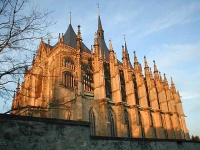
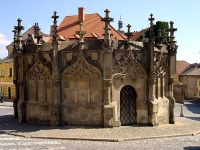
Left side: cathedral of st. barbara, right side: stone fountain
Origin: www.kutnahora.cz
Kutná Hora tour
1-4 pax. / sedan 68 EUR + waiting
5-8 pax. / minivan 85 EUR + waiting
9 pax. and more ask us
- Price here includes transfer, the waiting 200 CZK / 8 EUR / hour is NOT included.
- Price is per car, not per person.
- To book private guide contact our ATP Airport Transfer Prague operator or call our office: +420 728 876 876
Kutná Hora
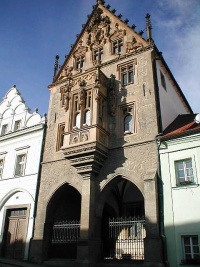
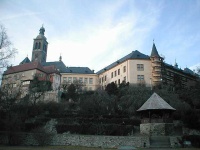
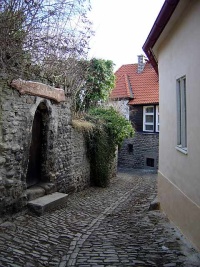
Left side: stone house, middle: italian court, right side: medieval street “ruthardka”
Origin: www.kutnahora.cz
The origins of Kutná Hora are usually linked with the development of monetary economy in the 13th century, however, the dawn of mining came a lot earlier. Surface traces of silver ore were probably discovered in the late 10th century by the Slavníks who had small silver coins – denars – struck at their settlement in Malín, today a part of Kutná Hora. Those coins, produced in 985-995, are circumscribed by "MALIN CIVITAS".
The awareness of silver wealth in the area is sometimes said to have spread along with the founding of the Cistercian monastery in Sedlec in 1142. The probability of this assumption, however, is reduced by the fact that the monastery had serious financial problems during the first century of its existence, which were solved only after the discovery of silver deposits.
After the initial vagueness in historical facts, let’s proceed directly to the discovery of local ore deposits. From the technical point of view, silver was discovered by prospectors that systematically surveyed the area of Českomoravská Vrchovina highlands. The first tangible record of mining and processing of silver ore in the 13th century is a nameless hamlet near Malín, which we have archaeological remains of. Rumours about rich silver deposits attracted new settlers, thousands of which were coming to the area mostly from neighbouring German speaking regions, bringing along advanced manufacturing technology and social system and thus becoming the leading group in the entire agglomeration. Immediate surroundings of particular shafts saw the construction of provisional dwellings, wooden chapels and primitive winding equipment. The atmosphere of Kutná Hora at that time may have resembled the atmosphere of American gold-miner’s settlements; contemporary records talk about a “rush to Kutná” and mention the fact that the fame of local mines spread across the border of the country.
The first mining settlements emerged without any plans and system and were thus granted no rights; all legal affairs had to be dealt with by the neighbouring towns of Kolín and Čáslav. For quite some time, those settlements were simply called Mons (mountain or hill) and the more specific name of MONS CUTHNA appeared only in 1289. The position of principal spiritual authority was logically adopted by the Cistercian monastery in Sedlec, that supervised the formation of legal and administration system.
The turning point in the town’s history came in 1300 when King Wenceslas II (1278-1305) issued the new royal mining code IUS REGALE MONTANORUM, a legal document of extreme importance that specified all administrative as well as technical terms and conditions necessary for the operation of mines. The new legal position of the agglomeration was supported by a number of privileges granted by kings of the Luxembourg dynasty, which gradually transformed the chaotic cluster of miner’s huts into the second most important town of the kingdom.
Shortly after 1300, Kutná Hora also became the seat of the central mint of the Czech lands, which was located in a small royal castle later called the Italian Court as a remembrance of Italian experts assisting with the planning and application of the minting reform. Mining of silver stood at one end of the manufacturing cycle, striking of silver coins (the so-called Prague Groschen and their parts – parvi) at the other one. Kutná Hora became the financial centre of the country.
During the first decades of existence of the town proper, the appearance of Kutná Hora did not correspond to the wealth being generated there. But that situation was to change soon. According to archaeological remains, the foundations of most burgher houses were laid in the beginning of the 14th century. Provisional wooden town walls of 1304 were gradually replaced by proper ramparts that had to be extended after some time, since the original layout proved to be too small for the quickly growing agglomeration. Considering medieval standards, the walled-up area was huge indeed, comparable perhaps only to Prague’s Old Town. Since 1320s, also the original wooden sanctuaries were outranked by more dignified structures – the so-called High Church began to be build (present-day Archdean’s Church of St. James, then dedicated to Our Lady) and soon followed the Church of Our Lady Na Náměti and other churches that have not survived. Within a short period of time, the municipality constructed social facilities, too, such as shops, baths and a hospital. In the late 14th century, self-confident municipal authorities could not cope any more with the disputes between Kutná Hora and the Cistercian monastery in Sedlec and decided to break free from the monastery on its strongest field of religious administration. Thus the decision dating from around 1380 to erect St. Barbara’s Cathedral outside the range of monastic jurisdiction was a manifestation of independence, based upon the seemingly inexhaustible deposits of silver.
Nonetheless, it was at the time of this important decision that the mining activities in Kutná Hora had to face first serious problems. Surface deposits were depleted and the descend under the surface called for more elaborate methods and techniques and more complicated technical equipment. Both mining and production of coins were inhibited for some time, which was immediately reflected in the quality of Prague Groschen.
The domination of German patriciate – descendants of the first settlers – governed the town’s attitude during the Hussite Wars. At the beginning, Kutná Hora stood firmly behind Emperor Sigismund. A series of Hussite triumphs in the course of 1421, however, deprived Kutná Hora of all hopes for keeping the warfare outside its limits. After the monastery in Sedlec was conquered and burnt down in May 1421, silver miners surrendered and anxiously awaited what was to come. The following period between 1422 and 1424 brought hard times to Kutná Hora, involving the expelling of some German miners and two devastating fires. Sinister consequences of those events brought all mining activities to a standstill that lasted until the last years of the reign of George of Poděbrady; then, in 1469, silver mining was restored to the extent that Prague Groschen began to be struck again in the Italian Court.
Two years later, in 1471, an assembly meeting took place in the Italian Court, resulting in the election of Polish king Vladislav II Jagello to king of Bohemia. Kutná Hora was in full blossom. Mining activities were fully restored and the coin production was sufficient enough to cover huge investment projects such as the construction of Prague Castle and Karlštejn Castle. The mining boom gave rise to a new entrepreneurial patriciate – this time mostly Bohemian businessmen and financiers. These people governed the life of the entire municipality and had an influence also in royal circles. They were members of the town council, assessors of the mining court and administrators of the particular mines. Thus it is no wonder that the overall atmosphere of Kutná Hora was an ideal breeding ground for corruption and various forms of fraud. The social tension culminated in 1494–1496: miner’s riots of that time have been considered the fiercest rebellion of the late Middle Ages.
The exceptional status of Kutná Hora was further strengthened by frequent visits of the sovereign and by the holding of assemblies; probably the most important assembly meeting was that of 1485, which witnessed the adoption of the so-called Religious Peace of Kutná Hora and thus confirmed the long period of religious tolerance.
In the early decades of the 16th century, Kutná Hora was a flourishing town with seemingly inexhaustible wealth. Mining zones, especially the Osel zone, were still producing reasonable yields, however, what was alarming was the fact that the miners had to descend about 500 metres under the surface; in such a depth, the risk of being flooded by ground water was very high and the thickness of silver ore was decreasing. These crisis symptoms began to grow stronger in 1530s and resulted in reduction of mining activities in the main zones. A real shock for locals was the closure of the most famous Osel mining zone in 1543. The only possible remedy would have been mass investments, but there was a continuous lack of resources.
The production of Prague Groschen – traditional pride of Kutná Hora – in the Italian Court was terminated in 1547. The newly introduced Thaler coins were, unjustifiably, considered an allogene phenomenon and linked with the discriminating attitude of the Habsburg court. Despite all that, the overall climate of the town in the 16th century seemed favourable. Mining yields of the Kaňk zone remained fairly reasonable, the mint was working at full capacity partly due to the import of silver ore and the town in general appeared rich and prosperous.
At the beginning of the 17th century, however, all the until then latent symptoms of crisis cropped out and grew on strength and it became clear that there is hardly any chance for remedy left. This complicated situation then coincided with the defeat at the Battle of the White Mountain. The most significant result of recent events were the infringements of religious freedom. During the first months after the battle, the progress of re-catholicisation was still moderate and municipal authorities made an effort to maintain freedom of worship for German Lutheran settlement of St. George in order to prevent mass emigration of miners and consequent lack of labour forces in the remaining mining zones. But imperial authorities were not satisfied with the slow progress of re-catholicization of Kutná Hora and in 1625, they committed the infamous troops of Colonel Huerta to speed up the process. The last nail in the coffin of religious freedom was the arrival of the Jesuits in Kutná Hora, who – with the support of Mr. Vřesovec, Master of the Mint – decided to build their college there.
Wartime brought immense trouble to Kutná Hora. Continuous increasing of taxes and contributions, confiscation of suburban estates and military troops passing through the town completely ruined municipal budget. Mining was not able to overcome further obstacles and was terminated and the lack of finance forced the town council to decide in 1625 that the mines in the Kaňk zone would be abandoned. The mint was producing debased coins made of imported silver or pagament. After a long struggle, the town received back its privileges in 1628, but the reinstated freedoms applied only to Catholic citizens.
During the Thirty Years War, two major raids of Swedish troops in 1639 and 1643 caused extensive damage to the town. The appearance of Kutná Hora in 1640s was very sad: houses were left empty by the emigrants or devastated by the Swedes, mines were abandoned as well with only a tiny number of miners left.
First indications of economic recovery occurred at the end of 1650s. Peaceful relations encouraged the development of crafts and trade and there appeared first attempts to bring mining back to life as well. Brightened financial situation enabled gradual re-acquisition and extension of municipal estates outside the town limits. Spiritual life was in the hands of the Jesuits. The Jesuit High School should be considered a positive achievement, since it was offering a fair amount of knowledge and educated many individuals that found their fulfilment in the order as well as outside of it.
The turn of the 18th century saw attempts to open new mines and restore the old fame of Kutná Hora as a mining town. But all hopes went down the drain. New silver veins were thin and their extraction consumed a lot of money, making them unprofitable. Such situation ended up in the closing of the mint in 1727. Although mining authorities still kept their seat in the Italian Court, the era of the mining town of Kutná Hora was definitely over. It still ranked among bigger towns in Bohemian context at the beginning of the 19th century – the number of inhabitants amounted to around six thousand in 1800 – but its significance was inevitably dwindling away and soon it was not able to keep pace with industrial revolution. For a long period of time, the only industrial plants were the Breuer Cotton-print Works (established in 1774) and the National Tobacco Factory in Sedlec (established in 1812 in the premises of the closed-down Cistercian monastery).
Inhabitants of Kutná Hora of that time consisted mostly of clerical intelligentsia, military officers (the garrison was established in 1749) and middle-class craftsmen and businessmen. Those were also responsible for most building activities, especially after 1823, when a big fire destroyed most houses in the eastern part of town.
The Czech national renascence left its traces in Kutná Hora especially in the minds of citizens who became proudly aware of the significance of their town and its glorious past. Many artists – mostly writers and painters – found inspiration in the romantic atmosphere of dark, curving lanes and majestic churches. The enchantment by the surrounding picturesque landscape can still be felt from the poetic depiction of it in the Czech national anthem by J. K. Tyl. It was the time of national renascence that witnessed the emergence of first historic writings about the history of Kutná Hora and its cultural monuments. There also appeared first disputes regarding the issue of preservation of cultural values, some of which were seriously damaged by the ravages of time – whether to preserve the town in its entirety, or to choose only the most important monuments. Nonetheless, such disputes were held only on the academic level at that time, since there was no money for major reconstruction and restoration of the town and the limited investments were targeted on the most dilapidated buildings including St. Barbara’s Cathedral, whose shape was more than critical after the mid-19th century. Fortunately, the reconstruction process was successful and the cathedral was festively re-consecrated in 1905.
Another monument in question was the once famous Italian Court; left by the mint and later also by the mining officers, it gradually became run-down to the extent that some of its parts threatened to tumble down any time. After complicated negotiations – involving even voices calling for wiping the building off the earth – it was decided that the Italian Court would be subject to general reconstruction, which was then carried out according to the project of Ludvík Lábler, co-author (with architect Mocker) of the reconstruction and completion project of St. Barbara’s Cathedral.
The dawn of the new republic of Czechoslovakia filled citizens of Kutná Hora with hopes that they would succeed in enlarging the town by new, modern quarters, and thus set up conditions for more dynamic development. Municipal authorities made an effort to encourage industry, crafts and trade and to attract younger population, however, they ran up against unfavourable development of transport, in particular of the railway system. For the entire inter-war period, Kutná Hora thus remained a town of monuments and tourists, a town rather quiet and a little sleepy. But such situation had also its bright spots, especially the high cultural level.
Building activities of the inter-war period that played an important role in shaping the areas immediately surrounding the historical centre of Kutná Hora were mostly in the hands of local architects and entrepreneurs, such as Rudolf Hraba (project of Tyl’s Municipal Theatre) or Rudolf Ryšán (project of the Land Technical School). Perhaps the most modern work of art is the Memorial of Fallen by sculptor Dvořák (created in 1933-1934) that is located in the little square in front of the historic building of the Hrádek museum and illustrates a creative symbiosis of historical environment and avant-garde art. Other examples of Czech modern architecture include houses by Kroha, the former district authority building by Machoň or the apartment house by Richard Podzemný. These buildings have shown how it is possible to incorporate an intact historical centre of a town in a modern and dignified frame.
Our small excursion in the history of Kutná Hora ends before the Second World War. The more recent historical turbulences have had no significant impact on historic and cultural features of the town. At least an elementary level of protection was granted by the inscription in the list of Czech cultural preserves. The struggle for adequate level of protection and preservation of historical and cultural values was accomplished in 1995, when Kutná Hora was inscribed on the UNESCO World Heritage List.
Origin: city Kutná Hora, http://www.kutnahora.cz/index.php?sec=2&cid=89
Ski Resorts
Nice mail from Richard
22.8.2017 I am happy to read e-mails like this.
Dinner with the Folklore
New pictures of cars
20.8.2013 New pictures of car fleet Airport Transfer Prague. Prague Castle square, 2013.